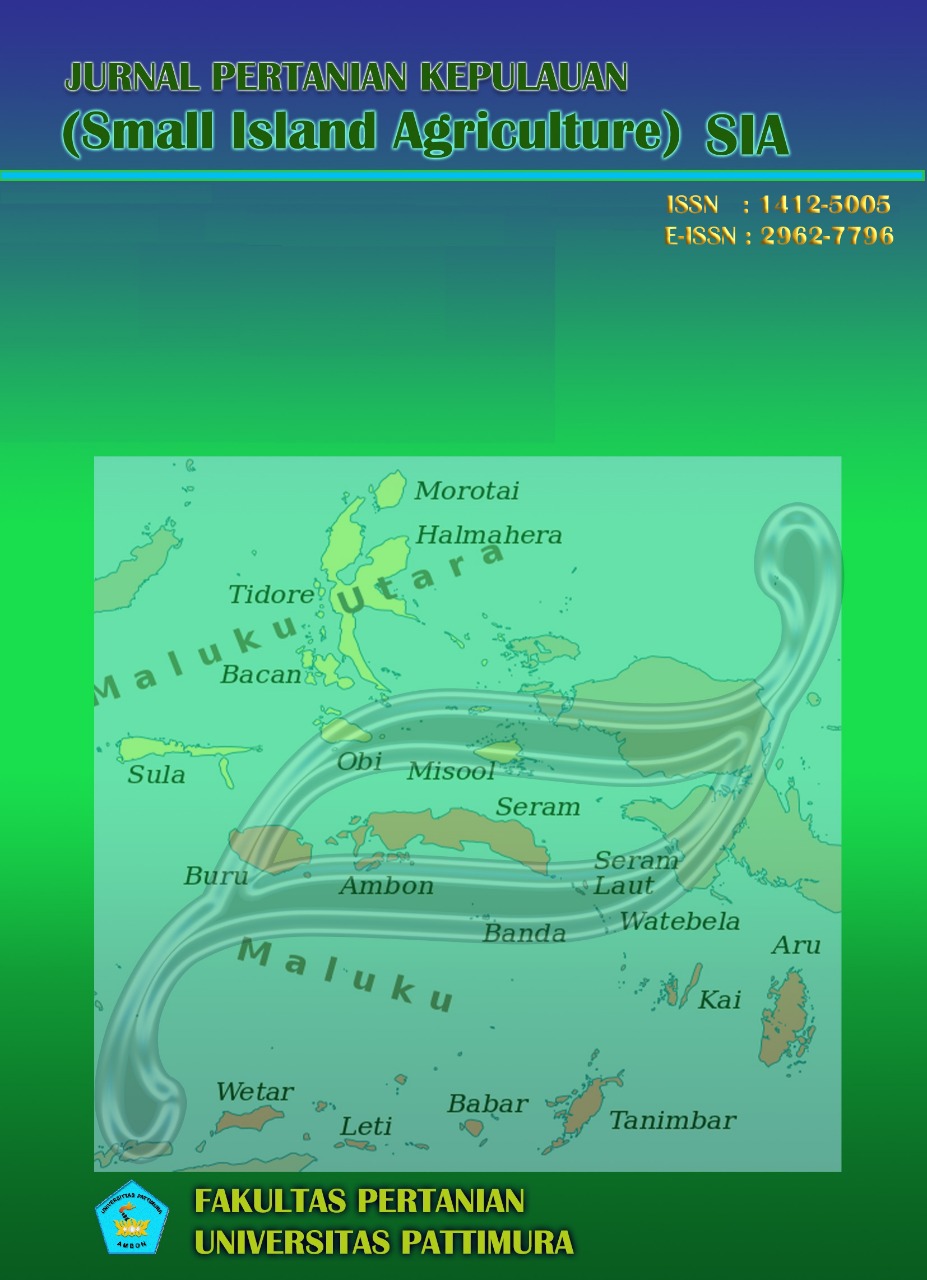Analisis Perbandingan Indeks Kemiripan Tanah pada Topsekuens Granit Gunung Sirimau Kota Ambon
Abstract
This study aims to identify and describe soil morphological traits in the granite toposequence and analyze these traits to assess the similarity index between soil profiles. This study used a survey method involving transect observations and complete profile observations. Variable soil observations were made in a downward direction, following each change in slope segment on the granite toposequence. The results showed that Cambisol (Dystrudepts) soils developed with physical and chemical properties on three profiles for soil color ranging from yellowish brown to brownish yellow and yellowish red to red. The soil texture ranges from loamy sand to dusty clay, and the soil structure is rounded cubical. The soil has an acidic to slightly acidic pH and a slightly sticky consistency when moist and very low to low C-organic content. The similarity index assessed in the three profiles includes parameters such as dust/clay ratio, pH H₂O, and C-organic, which are very similar due to the similarity of the constituent rock formations.
Downloads
References
Azizah, C., Nuraida, N., & Robo, S. (2022). Karakteristik Tanah Dan Iklim Sebagai Indikator Hidrologi Di Daerah Aliran Sungai Tamiang Provinsi Aceh. Jurnal Lingkungan Almuslim, 1(2). https://doi.org/10.51179/jla.v1i2.1345
Baisden, W. T. (2001). Soils: An Introduction, Fifth Edition. Eos, Transactions American Geophysical Union, 82(47). https://doi.org/10.1029/01eo00337
BBSDLP. (2015). Soil Survey Staff (Ketiga). BALITBANGTAN.
Brady, N. C., & Weil, R. R. (2010). Elements of the Nature and Properties of Soils (3rd ed.). Pearson.
Brady, N. C., & Weil, R. R. (2017). The Nature and Properties of Soils (15th ed.). Pearson Education.
Buol, S. W., Hole, F. D., & McCracken, R. J. (1980). Soil Genesis and Classification (2nd ed.). The Iowa State University Press.
Eswaran, H., & Sys, C. (1970). An evaluation of the free iron in tropical andesitic soils. Pedologie, 20, 62–66.
Fiantis, D. (2017). Morfologi Dan Klasifikasi Tanah. In MORFOLOGI DAN KLASIFIKASI TANAH. https://doi.org/10.25077/car.4.2
Irham, W. H., Saragih, S. W., Parinduri, S., Sitepu, M. T., & Tua, S. N. P. (2024). Reaksi Tanah Akibat Perbedaan Perlakuan Lingkungan. Tabela Jurnal Pertanian Berkelanjutan, 2(1). https://doi.org/10.56211/tabela.v2i1.445
Kumar, N., Gangola, S., Bhatt, P., Jeena, N., & Khwairakpam, R. (2019). Soil Genesis, Survey and Classification. In Mycorrhizosphere and Pedogenesis. https://doi.org/10.1007/978-981-13-6480-8_8
Kurnia, U. (2006). Sifat fisik tanah dan metode analisisnya. Balai Besar Penelitian dan Pengembangan Sumberdaya Lahan Pertanian. BBSLP.
Laliberté, E., Grace, J. B., Huston, M. A., Lambers, H., Teste, F. P., Turner, B. L., & Wardle, D. A. (2013). How does pedogenesis drive plant diversity? In Trends in Ecology and Evolution (Vol. 28, Issue 6). https://doi.org/10.1016/j.tree.2013.02.008
Lattupeirissa, A. A., Luhukay, M., & Risamasu, R. G. (2022). Karakteristik Fisik, Kimia dan Mineral Tanah Di Lokasi Kampus IAIN- Ambon Kecamatan Sirimau Kota Ambon. JURNAL PERTANIAN KEPULAUAN, 6(2). https://doi.org/10.30598/jpk.2022.6.2.72
Marto, A., Kasim, F., & Mohd Yusof, K. N. (2018). Mineralogi, Mikrostruktur dan Komposisi Kimia Tanah Baki Granit Semenanjung Malaysia. Malaysian Journal of Civil Engineering, 14(1). https://doi.org/10.11113/mjce.v14.15649
Notohadiprawiro, T. (2006). Tanah dan Lingkungan. Repro: Ilmu Tanah Universitas Gadjah Mada.
Putri, M. D., Baskoro, D. P. T., Tarigan, S. D., & Wahjunie, E. D. (2017). Karakteristik Beberapa Sifat Tanah Pada Berbagai Posisi Lereng Dan Penggunaan Lahan Di Das Ciliwung Hulu. Jurnal Ilmu Tanah Dan Lingkungan, 19(2). https://doi.org/10.29244/jitl.19.2.81-85
Retallack, G. J. (2001). Soils of the Past: An Introduction to Paleopedology. Blackwell.
Reza, S. K., Alam, N. M., Mukhopadhyay, S., Nayak, D. C., Sahoo, A. K., Singh, S. K., Dwivedi, B. S., Maurya, D., & Mukhopadhyay, J. (2023). Quantification of soil quality index using pedo-morphological data of alluvial soils of indo-gangetic plains, India. Archives of Agronomy and Soil Science, 69(7). https://doi.org/10.1080/03650340.2022.2067982
Risamasu, R. G. (2001). Perkembangan Tanah Banjar Litologi dan Topografi (Litho-Toposekuens) Granit, Peridotit Di Jazirah Leitimur Pulau Ambon.
Saputra, E., Putu, S., Susilowati, L. E., & Dewi, R. A. S. (2023). Populasi Bakteri dan Respirasi Mikroba Tanah pada Rhizosfer Tanaman Jagung ( Zea mays L.) yang diberi Pupuk Terpadu dan Biochar Sekam Padi pada Masa Vegetatif Maksimum. AGROTEKSOS, 33(2). https://doi.org/10.29303/agroteksos.v33i2.859
Subardja, D. , Ritung, S., Anda, M., Sukarman, Suryani, E., & Subandiono, R. (2014). Petunjuk Teknis Klasifikasi Tanah Nasional. Balai Besar Penelitian dan Pengembangan Sumberdaya Lahan Pertanian, Badan Penelitian dan Pengembangan Pertanian.
Torrent, J., Barrón, V., & Liu, Q. (2006). Magnetic enhancement is linked to and precedes hematite formation in aerobic soil. Geophysical Research Letters, 33(2). https://doi.org/10.1029/2005GL024818
Van Sleen, L. A. (1984). Physiography and Soils. Part I. Fundamental Relationship and Perspective. International Institute for Aerial Survey and Earth Sciences.
Verbeek, R. D. M., & den Bos, W. (1898). Geologische Kaart van Ambon.
Copyright (c) 2025 Irmanji Umanailo, Robby G Risamasu, Ferad Puturuhu, Marcus Luhukay

This work is licensed under a Creative Commons Attribution 4.0 International License.





.png)


